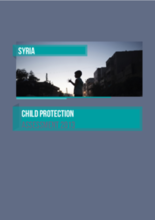This report just issued by the Child Protection Working Group (CPWG) presents the main findings of an interagency child protection assessment for Syria, covering the period February- May 2013. Due to restricted humanitarian access inside Syria, a remote methodology was used comprising three components: a desk review of existing Syria literature; resource person interviews with newly arriving refugees; and humanitarian worker interviews. Data covered the governorates of Aleppo, Al-Hassakeh, Damascus, Dar’a, Homs, Idleb, and Rural Damascus. The report provides findings on key thematic areas: psychosocial wellbeing, physical violence, children associated with armed forces and armed groups, child marriage, sexual violence, child labour, separation from caregivers and access to basic services and information.
Of particular relevance to children's care situations, information gathered through the assessment clearly indicates that children are being separated from their usual caregivers as a result of the conflict, and that there is a growing caseload of both separated and unaccompanied children. The assessment found, however, that many caregivers do not register changes in care arrangements with local authorities, possibly owing to the predominance of informal kinship care arrangements and the fear of sharing information in the current context. Analyses of trends reported in other assessments conducted in surrounding refugee-receiving countries found separation was initiated in Syria for a range of reasons, including safety, access to services, economic reasons, prevention of recruitment into armed forces and armed groups, and to protect girls from sexual assault. For example, an assessment conducted in Jordan in April 2013 reported that 1,000 separated children and 1,300 unaccompanied children had been identified. 41% of the children had separated for reasons of family reunification, 27% for safety and 11% for access to services. An assessment in Iraq found separation is initiated in Syria as a protection mechanism to prevent recruitment into armed forces/armed groups, for economic reasons and to protection girls from sexual assault.
In the current assessment, 74% of respondents reported that there were separated children as a result of the conflict, 40% of respondents reported there were unaccompanied children. Respondents believed separation was usually accidental (82%) due to death of parents, losing parents during movement to safer areas or disappearance during the conflict. A small proportion of respondents (16%) described separation taking place by choice, for example, families sending children to work or to stay with relatives, friends or in institutional care (as protection against recruitment into armed forces and armed groups, sexual violence or other threats) or sending children to locations where they may be better able to access basic services. However, the rate of deliberate separation is likely to be higher than the data suggests.
Most respondents (57%) were aware of families who had sent children out of Syria with an unrelated person or without any adult care, and cited their motivations as safety (91%), economic hardship (39%), avoidance of being used by armed forces and armed groups (48%). These causes are also reflected in information gained through case management of newly arrived separated and unaccompanied children in Jordan and Iraq.
The majority of children separated from their parents live in kinship care arrangements in the community, with communities reporting relatively high capacity to support at community level, corroborating the pre-conflict cultural norm. The reports suggest that deteriorating economic situation may adversely impact this positive community response, as indicated by a small proportion of respondents who stated they would “do nothing” (3%) if they came across an accompanied child. When these respondents were asked why, responses mostly related to an inability to provide for the child. The report states that there may already be a significant number of unaccompanied children living without adult care on the street or on their own (respondents reported children living in such conditions).
Deterioration in the psychosocial wellbeing of children was also reported by 98% of respondents. Boys and girls appear to be equally affected. Respondents indicated the main behaviour changes in boys and girls as unusual crying/screaming, disruption in sleep patterns, sadness, bed-wetting and unwillingness to go to school. Respondents reported two main categories of changes in the behaviour of caregivers. First, increased tendency to limit children’s mobility outside of home, including keeping children from going to school; and second, changes in attitude, demonstrated through changing attention to needs (less/more), time devoted to children (less/ more) and changing levels of aggression or affection shown.
The report makes a range of recommendations in relation to the international humanitarian response, highlighting first of all the need to advocate with all parties to the conflict for the immediate cessation of all violations killing and maiming of children (including due to the use of explosive weapons); the recruitment and use of children; sexual violence against children; and the detention and torture of children. Care related recommendations include, ensuring that any potential unintended risks that could be caused through the provision of humanitarian aid is mitigated, including incentivizing separation from caregivers by the provision of special benefits of assistance to families; Addressing household economic vulnerability that may lead to child protection concerns, including separation, and target support to households whose structure has changed, for example due to death, disappearance, injury or displacement (including single-parent, elderly, person with disability, households caring for additional children and child-headed households); the development and dissemination of risk reduction messages in collaboration with communities, including on the importance of prevention of family separation and risks related to it, and the promotion of family-based care for children identified as separated or unaccompanied; and addressing reported causes of stress reported by adult caregivers.

